Sonus Paradisi
Smecno, 1587 [Haupwerk]
Smecno, 1587 [Haupwerk]
No se pudo cargar la disponibilidad de retiro
Smecno - historia del órgano (aprox. 1587)
El instrumento renacentista de la iglesia de la Santísima Trinidad en Smecno es el órgano preservado y tocable más antiguo de la República Checa.
El instrumento fue construido alrededor del año 1587. La fecha de construcción puede ser fácilmente reconocida por la heráldica de los donantes representada en el arca del órgano y por los materiales de archivo existentes. El constructor del órgano es desconocido. Se sabe que el instrumento fue dañado durante la guerra de los treinta años en 1631 cuando los soldados del ejército sueco robaron el Regal - el único registro de lengüeta. Ha habido una gran reconstrucción durante su historia: a finales de la era barroca, en 1775, se añadió un pequeño Rückpositiv por Jan Rusch de Litomerice y se cambiaron algunos registros.
Una reconstrucción parcial del órgano al estado renacentista fue realizada por Dusan Doubek antes de 1999. Durante los años 2009-2010, la reconstrucción del órgano continuó. En nuestro modelo virtual del órgano, presentamos el estado del órgano antes y después de la última restauración. El instrumento fue grabado antes de que los organeros lo tocaran, y después de que completaron su trabajo. Aquí es donde se logra el objetivo principal de nuestro proyecto: la documentación sonora del órgano dado en varios momentos de su historia.
Esta forma absolutamente única e innovadora de documentación sonora es posible gracias a la tecnología Hauptwerk.
Presentado a usted por Leonart Studio, su revendedor autorizado de Sonus Paradisi en Suiza (enviado internacionalmente). Obtenga sus órganos históricos muestreados digitalmente para su uso con el software de instrumento virtual Hauptwerk.
Comparte este Conjunto de Muestra
![Smecno, 1587 [Haupwerk]](http://artful.shop/cdn/shop/files/ss_smecno1.jpg?v=1692887377&width=1445)
![Smecno, 1587 [Haupwerk]](http://artful.shop/cdn/shop/files/ss_smecno2.jpg?v=1692887377&width=1445)
![Smecno, 1587 [Haupwerk]](http://artful.shop/cdn/shop/files/ss_smecno3.jpg?v=1692887378&width=1445)
![Smecno, 1587 [Haupwerk]](http://artful.shop/cdn/shop/files/ss_smecno4.jpg?v=1692887378&width=1445)
![Smecno, 1587 [Haupwerk]](http://artful.shop/cdn/shop/files/ss_smecno12_0f900822-2a61-43b0-82c1-b8cf8b046f70.jpg?v=1692889477&width=1445)
Especificación (lista de detención)
-
Manual I
El Positiv
Copula 8'
Copula 4'
Fugara 4'
Principal 2'
Quinta 1 1/2'
Octava 1' -
Manual II
Choro primo windchest:
Principale 8' (Prospekt)
Cimbale 2x 1/2'
Mixtura 3x 1'
Superoctava 2'
Quinta maior 2 2/3'
Octava principale 4'
Choro secondo windchest:
Salicinale 8'
Copula maior 8'
Copula minor 4'
Quintadena 4' -
Manual III
Versión extendida con:
Choro primo caja de viento
- antes de la reconstrucción
Choro secondo caja de viento
- antes de la reconstrucción
La versión extendida (alrededor) añade un registro Regal. -
Manual IV
-
-
Pedal
Pedal windchest
Superoctavasus 4'
Octavasus 8'
Subbasus 16' -
Otra especificación
"m" y "p" representan los acopladores añadidos virtualmente:
el acoplador [m]anual y el acoplador [p]edal respectivamente.
El instrumento original en sí no posee ningún acoplador; de hecho, el positivo barroco y el órgano renacentista están separados, por lo que no es posible tocarlos simultáneamente.
Historia
Smecno - historia del órgano (ca. 1587)
El instrumento renacentista de la iglesia de la Santísima Trinidad en Smecno es el órgano más antiguo preservado y tocable en la República Checa.
El instrumento fue construido alrededor del año 1587. La fecha de construcción puede ser fácilmente reconocida por la heráldica de los donantes representada en el cuerpo del órgano y por los materiales de archivo existentes. El constructor del órgano es desconocido. Se sabe que el instrumento fue dañado durante la guerra de los treinta años en 1631, cuando los soldados del ejército sueco robaron el Regal - el único registro de lengüeta. Ha habido una gran reconstrucción durante su historia: en la tardía era barroca, en 1775, se añadió un pequeño Rückpositiv por Jan Rusch de Litomerice y se cambiaron algunos registros.
Una reconstrucción parcial del órgano al estado renacentista fue realizada por Dusan Doubek antes de 1999. El Rückpositiv barroco fue removido y el único manual en el estuche renacentista fue renovado. Los nombres de los registros originales se conservaron en los jambas de los registros y también se encontró un gran número de tubos originales dentro del órgano. Esto permitió la reconstrucción del sonido especial renacentista de los registros individuales. Sin embargo, esta reconstrucción permaneció solo parcial, ya que el instrumento se dejó a una presión bastante alta (debido a los tubos de pedal más nuevos - el pedal no fue parte del trabajo de reconstrucción de Doubek) y, por lo tanto, los tubos tenían un sonido bastante áspero.
Durante los años 2009-2010, la reconstrucción del órgano continuó. El Rückpositiv barroco ahora es completamente funcional, aunque permaneció separado del órgano renacentista, teniendo su propio teclado y registros opuestos al cuerpo principal. Por lo tanto, el organista no puede tocar los dos manuales al mismo tiempo. O se puede tocar el órgano renacentista solo, o el Positiv solo.
Sin embargo, se tomó la decisión de corregir la presión del viento dentro del instrumento renacentista junto con los ajustes de afinación necesarios y también se realizaron una serie de correcciones menores al rastreador, al viento y a las partes mecánicas del instrumento, de modo que ahora se puede considerar finalizada la reconstrucción de la parte antigua del instrumento. Estamos orgullosos de haber podido patrocinar esta última parte de la reconstrucción con el dinero del proyecto Sonus Paradisi.
En nuestro modelo virtual del órgano, presentamos el estado del órgano antes y después de la última restauración. El instrumento fue grabado antes de que los organeros lo tocaran y después de que completaron su trabajo. Aquí es donde se logra el objetivo principal de nuestro proyecto: la documentación sonora del órgano dado en varios momentos de su historia. Podemos presentar ambas variantes del sonido del instrumento dentro de Hauptwerk, lado a lado, para que cada oído pueda escuchar cómo exactamente cambió el sonido del instrumento al presionar solo un botón que alterna entre los conjuntos de muestras de antes/después de la reconstrucción. Esta forma absolutamente única e innovadora de documentación sonora es posible gracias a la tecnología Hauptwerk.
La composición del instrumento renacentista
El manual renacentista único está construido sobre dos cajas de viento separadas. La primera contiene solo el coro principal mientras que la otra las flautas. Hay válvulas que permiten silenciar cualquiera de las cajas de viento. Pueden ser activadas por registros llamados en estilo italiano "Choro primo" y "Choro secondo". Esto hace posible cambiar rápidamente el sonido del órgano entre el plenum principal y las pequeñas flautas, imitando así una interpretación de dos manuales. La tabla muestra cómo se distribuyen los registros en las cajas de viento. Antes de comenzar a tocar, por favor no olvide tirar de cualquiera de los registros Choro primo o Choro secondo para escuchar algún sonido.
MANUAL
Caja de viento Choro primo
Principale 8' (Prospekt)
Cimbale 2x 1/2'
Mixtura 3x 1'
Superoctava 2'
Quinta maior 2 2/3'
Octava principale 4'
MANUAL
Caja de viento Choro secondo
Salicinale 8'
Copula maior 8'
Copula minor 4'
Quintadena 4'
PEDAL
Caja de viento del pedal
Superoctavasus 4'
Octavasus 8'
Subbasus 16'
Está afinado en la afinación histórica de cuarto de coma. El compás del instrumento: C1 - C5 en la terminología de Hauptwerk, octava baja corta.
El Rückpositiv barroco
La composición del Rückpositiv barroco es muy similar a un tipo típico checo del instrumento.
Copula 8'
Copula 4'
Fugara 4'
Principal 2'
Quinta 1 1/2'
Octava 1'
El compás es de cuatro octavas, la octava más baja es corta, es decir, sin los semitonos. Usando nuestro modelo virtual de Hauptwerk, el Rückpositive se puede escuchar en el manual más bajo utilizando la versión "extendida" del conjunto de muestras.
Características
El órgano fue grabado tubo por tubo antes y después de la reconstrucción. Ambas versiones están disponibles lado a lado en Hauptwerk, hay un botón especial para alternar entre los conjuntos de muestras antes/después de la reconstrucción. Por lo tanto, el cambio en el timbre puede compararse instantáneamente en Hauptwerk sin necesidad de descargar/cargar la otra versión.
Smecno - Gráfico de Temperamento
se creó un gráfico de afinación dedicado que presenta el Temperamento Original del órgano de Smecno, para que puedas cargarlo en cualquier momento y usarlo junto con las muestras de Smecno. Se recomienda su uso. El órgano renacentista de Smecno está afinado en 4-tercera coma Meantone. El gráfico de afinación de Smecno se instalará junto con el conjunto de muestras de Smecno. Se aconseja encarecidamente utilizar este gráfico de temperamento en lugar de la "Afinación Original del Órgano", que conserva también todas las imperfecciones de afinación casual del órgano en el momento de la grabación.
El positivo barroco de Smecno está afinado en el temperamento Werckmeister III. Este temperamento está disponible en la carpeta de temperamentos de Hauptwerk por defecto.
Resolución de pantalla
Todas las versiones del conjunto de muestras requieren una resolución de pantalla de 1280x1024 px. La versión original, si se utiliza con una pantalla táctil doble, debe habilitarse el pivote, ya que los jambas de parada divididos están diseñados para una vista en retrato. La versión extendida no requiere el pivote.
Smecno - Original
Este conjunto de muestras es el documento digital que presenta el estado actual del órgano junto con el estado del órgano antes de la reconstrucción. La alternancia entre las dos versiones se realiza haciendo clic en el botón especial en la esquina inferior izquierda de la pantalla de la consola. También hubo una diferencia en el volumen: el órgano antes de la reconstrucción era demasiado ruidoso, después de la reconstrucción el nivel de volumen se ajusta a las dimensiones de la iglesia. Atenuamos deliberadamente todas las paradas de la parte antes de la reconstrucción del conjunto de muestras en 3 dB. Esto facilita la comprensión del cambio en el timbre, en lugar de concentrarse en el cambio en el volumen.
Las paradas se dividen en tres grupos de caja de viento como se muestra en la tabla. Tiene un manual (teclado) más pedal con la octava más baja corta (las teclas C#, D#, F#, G# están ausentes).
Smecno - Extendida
El conjunto de muestras expande las divisiones del instrumento en diferentes manuales: el Rückpositive barroco está configurado en el manual más bajo, el Gran Órgano renacentista está configurado en el segundo manual, y el manual más alto está reservado para el Gran Órgano de Smecno antes de la reconstrucción. Nuevamente, esta es una vista diferente del estado del instrumento antes/después de la reconstrucción. Al tocar en el segundo y el manual superior, puedes comparar rápidamente el sonido del órgano antes y después de la reconstrucción. La lista de paradas extendida se puede ver fácilmente en la captura de pantalla de la consola.
La versión extendida añade una parada Regal al tercer manual (no mostrada en la captura de pantalla).
Los botones semitransparentes en la esquina inferior derecha etiquetados como "m" y "p" representan los acopladores virtualmente añadidos: el acoplador [m]anual y el acoplador [p]edal respectivamente. El órgano en sí no posee ningún acoplador. De hecho, el positivo barroco y el órgano renacentista están separados, por lo que no es posible tocarlos simultáneamente.
Por favor, ten en cuenta nuevamente que los generales añadidos son puramente virtuales. El general etiquetado como "x" representa el botón de combinación de Cancelación General.

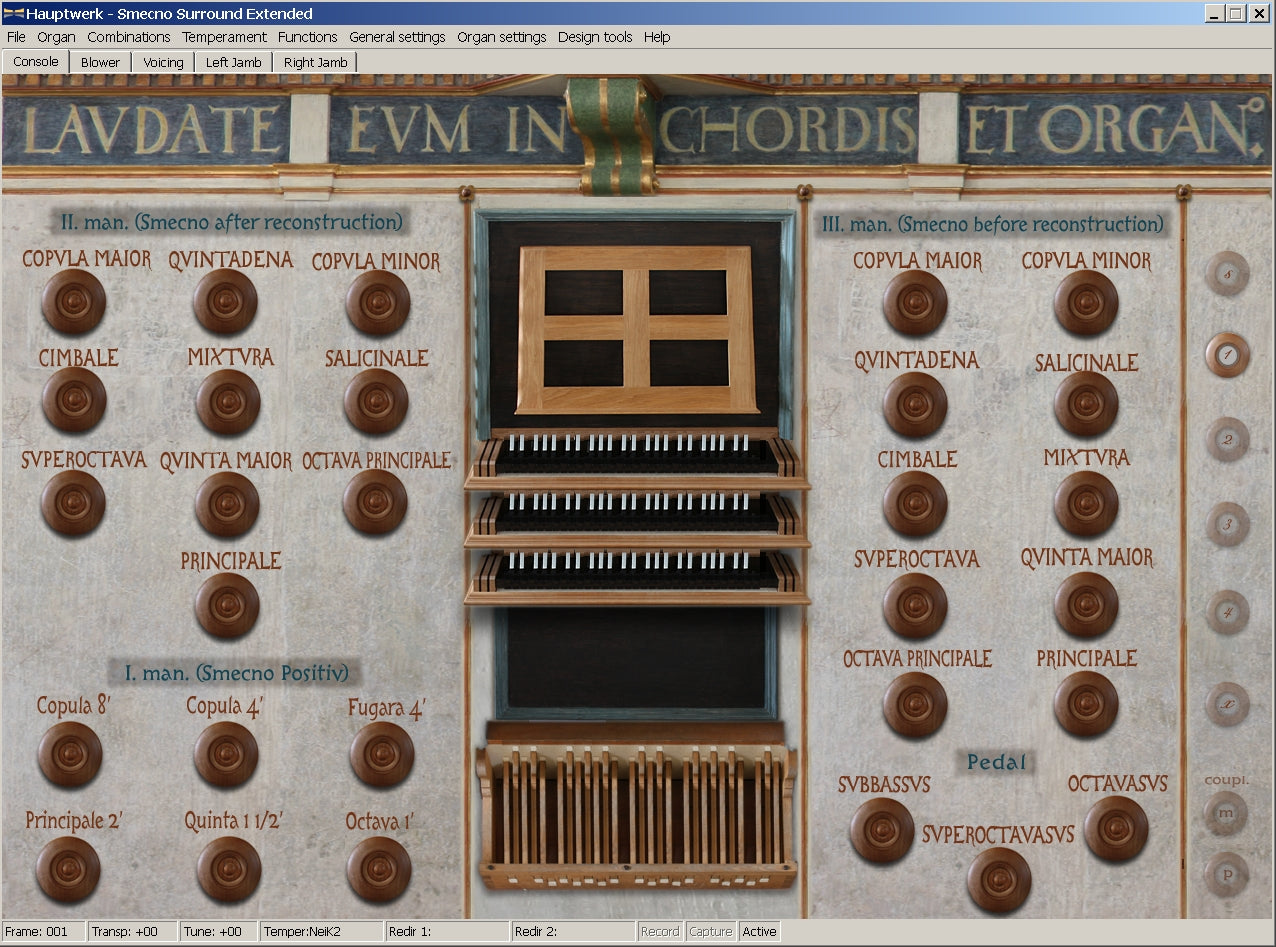

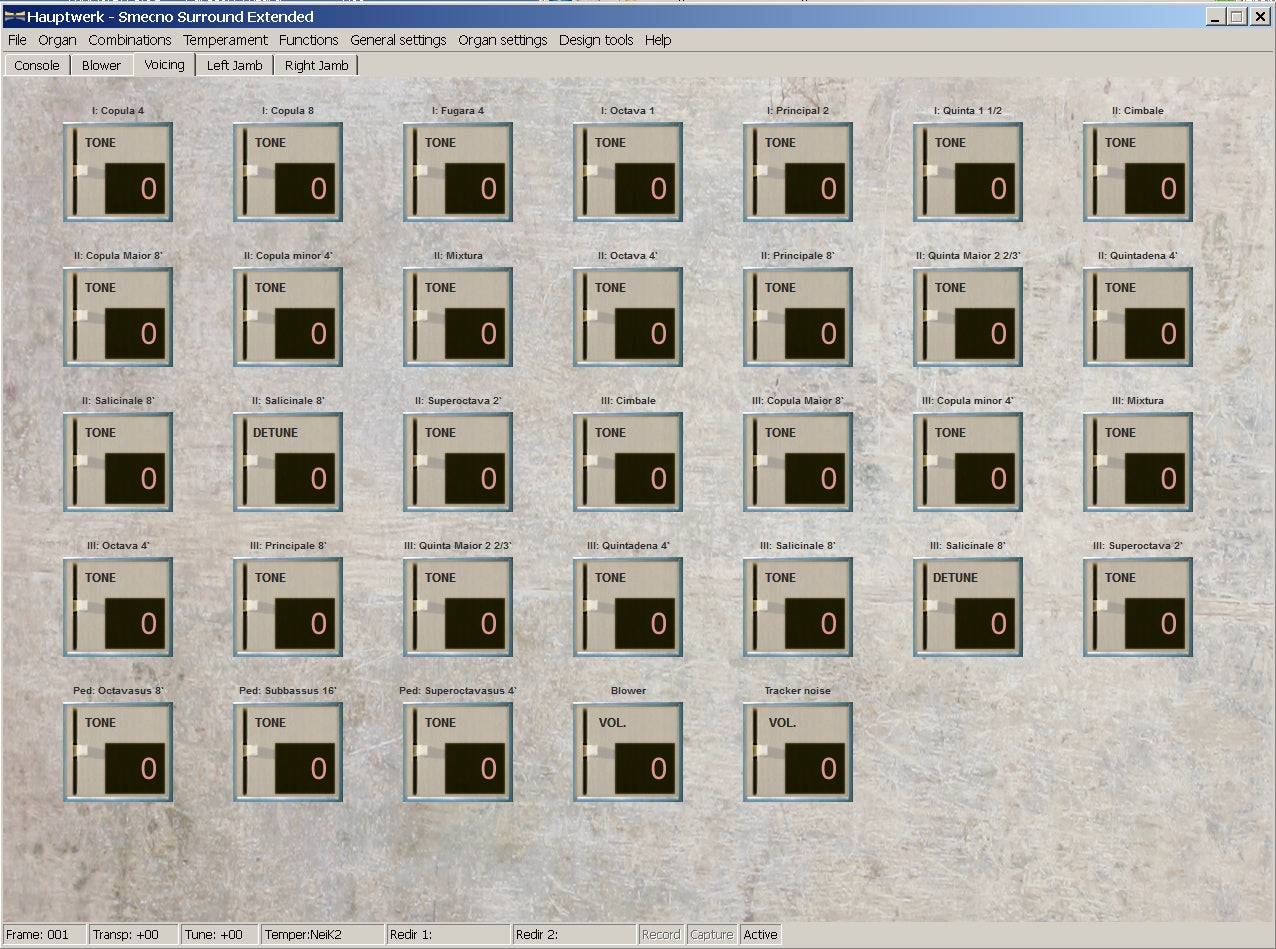
Requisitos
Hauptwerk v.4.2 y versiones superiores soportadas.
Las muestras se ofrecen en calidad de 24bit/48kHz, múltiples lanzamientos (3 niveles). Forma de onda simple (sin encriptación). El tiempo de reverberación es de hasta 2.5 segundos para las versiones ambientales. El conjunto de muestras se presenta en 3 versiones diferentes:
Seco:
grabación en primer plano, las muestras resultantes casi secas están disponibles en dual-mono (canales izquierdo y derecho). Aunque se grabaron en primer plano, siempre hay una ligera reverberación presente en las muestras. Esta vez, optamos por dejar estos pequeños fragmentos de reverberación en las muestras, sin silenciarlos. Por esta razón, el conjunto de muestras no es completamente seco, sino "húmedo". Los lanzamientos pueden ser truncados en el Hauptwerk mismo, si el usuario lo desea. La comparación de sonido antes/después de la reconstrucción está disponible.
Consumo de RAM:
carga completa, 16-bit: 3.4 GB
carga completa, 20-bit: 5.0 GB
carga completa, 24-bit: 6.3 GB
Húmedo:
grabación a distancia que captura la acústica original de la iglesia, estándar para conjuntos de muestras de Hauptwerk. La comparación de sonido antes/después de la reconstrucción está disponible.
Consumo de RAM - muy similar al conjunto Seco.
Surround: la grabación surround utiliza 4 canales independientes para cada tubo virtual (para cada muestra). El sonido de los tubos del órgano es capturado por los micrófonos frontales, la respuesta de la iglesia por los micrófonos traseros. Los 4 canales se extraen de la grabación y se ensamblan en el conjunto de muestras. Los dos canales frontales se utilizan para suministrar el sonido del órgano a los altavoces frontales, mientras que los otros 2 canales ofrecen la respuesta de la iglesia. Puedes usar estos dos canales para alimentar tus altavoces surround (traseros). Ten en cuenta que se necesitan al menos 4 altavoces para reproducir el audio multicanal. La comparación de sonido antes/después de la reconstrucción está disponible.
Consumo de RAM:
carga completa: 16-bit: 5.8 GB
carga completa: 20-bit: 8.6 GB
carga completa: 24-bit: 11.2 GB
Las versiones Húmedo y Surround se ofrecen en un solo ODF. Por favor, consulta el cuadro de diálogo de enrutamiento de rango para más detalles y la figura a continuación para una descripción.
Este conjunto de muestras de Hauptwerk se presenta a usted por Leonart Studio, un revendedor autorizado del fabricante Sonus Paradisi en Suiza (envíos internacionales). Disfrute de esta biblioteca de órganos muestreados digitalmente para su uso con el software Hauptwerk y comience a expandir su colección de órganos históricos hoy mismo.
Más conjuntos de muestras Hauptwerk
-
Casavant, 1995 [Obra principal]
Proveedor:Sonus ParadisiPrecio habitual CHF 174.90Precio habitualPrecio unitario / por -
Bückeburg, 1997 [Obra principal]
Proveedor:Sonus ParadisiPrecio habitual A partir de CHF 1.10Precio habitualPrecio unitario / por -
Schwerin, Dom, Ladegast Organ 1871 [Hauptwerk]
Proveedor:Sonus ParadisiPrecio habitual CHF 616.00Precio habitualPrecio unitario / por -
Segovia, 1772 [Obra maestra]
Proveedor:Sonus ParadisiPrecio habitual CHF 317.90Precio habitualPrecio unitario / por -
Reuter, 1928 [Obra principal]
Proveedor:Sonus ParadisiPrecio habitual CHF 473.00Precio habitualPrecio unitario / por -
Rotterdam Hoofdorgel, 1973 [Hauptwerk]
Proveedor:Sonus ParadisiPrecio habitual A partir de CHF 330.00Precio habitualPrecio unitario / porCHF 958.10Precio de oferta A partir de CHF 330.00Oferta -
Groninga, 1450-1740 [Obra principal]
Proveedor:Sonus ParadisiPrecio habitual A partir de CHF 658.90Precio habitualPrecio unitario / porCHF 1,681.90Precio de oferta A partir de CHF 658.90Oferta -
Frankfurt a.d. Oder, 1975 [Obra principal]
Proveedor:Sonus ParadisiPrecio habitual A partir de CHF 220.00Precio habitualPrecio unitario / porCHF 550.00Precio de oferta A partir de CHF 220.00Oferta -
Piacenza, 1838 [Obra principal]
Proveedor:Sonus ParadisiPrecio habitual CHF 330.00Precio habitualPrecio unitario / por -
Lüdingworth, 1683 [Obra principal]
Proveedor:Sonus ParadisiPrecio habitual CHF 330.00Precio habitualPrecio unitario / por

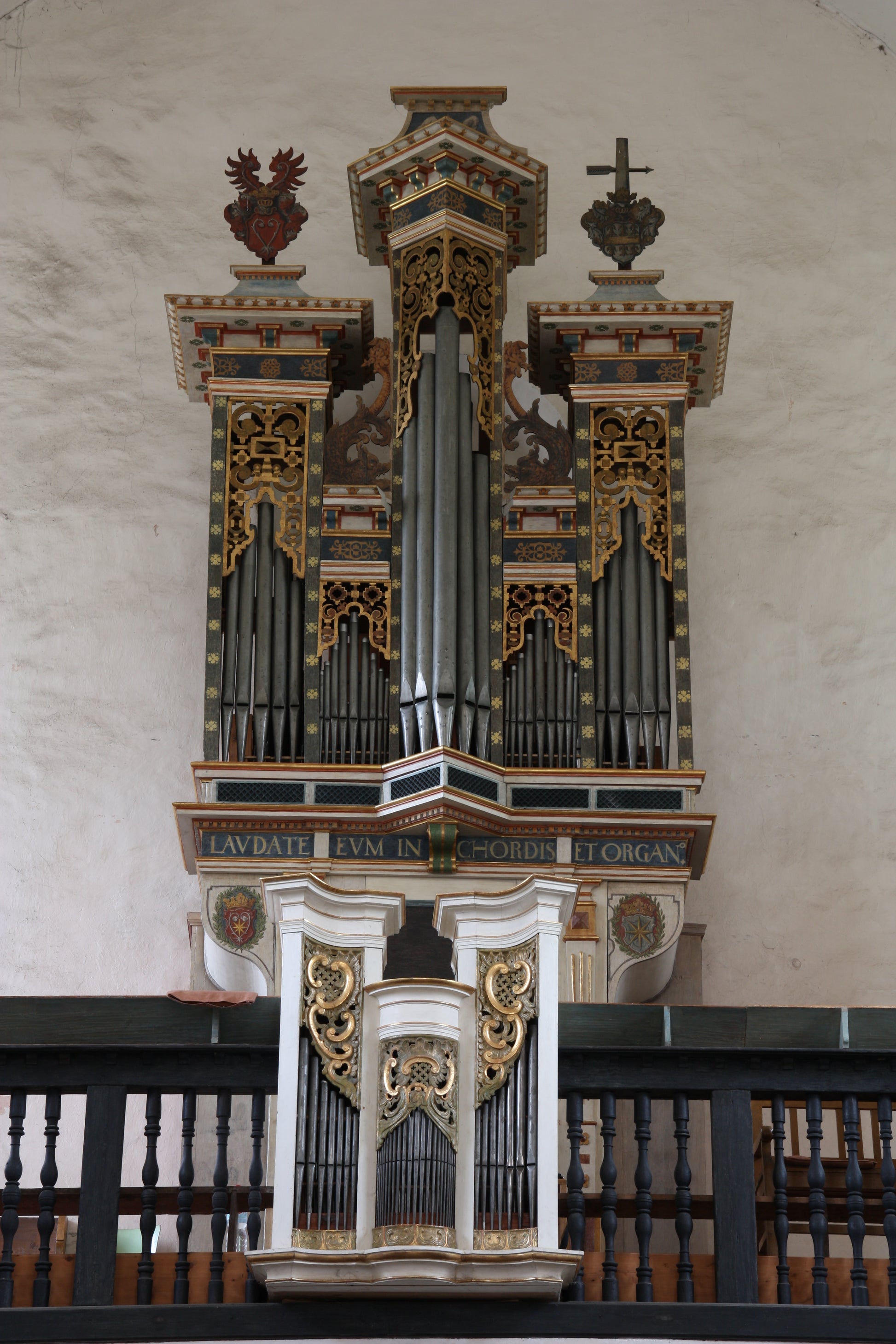
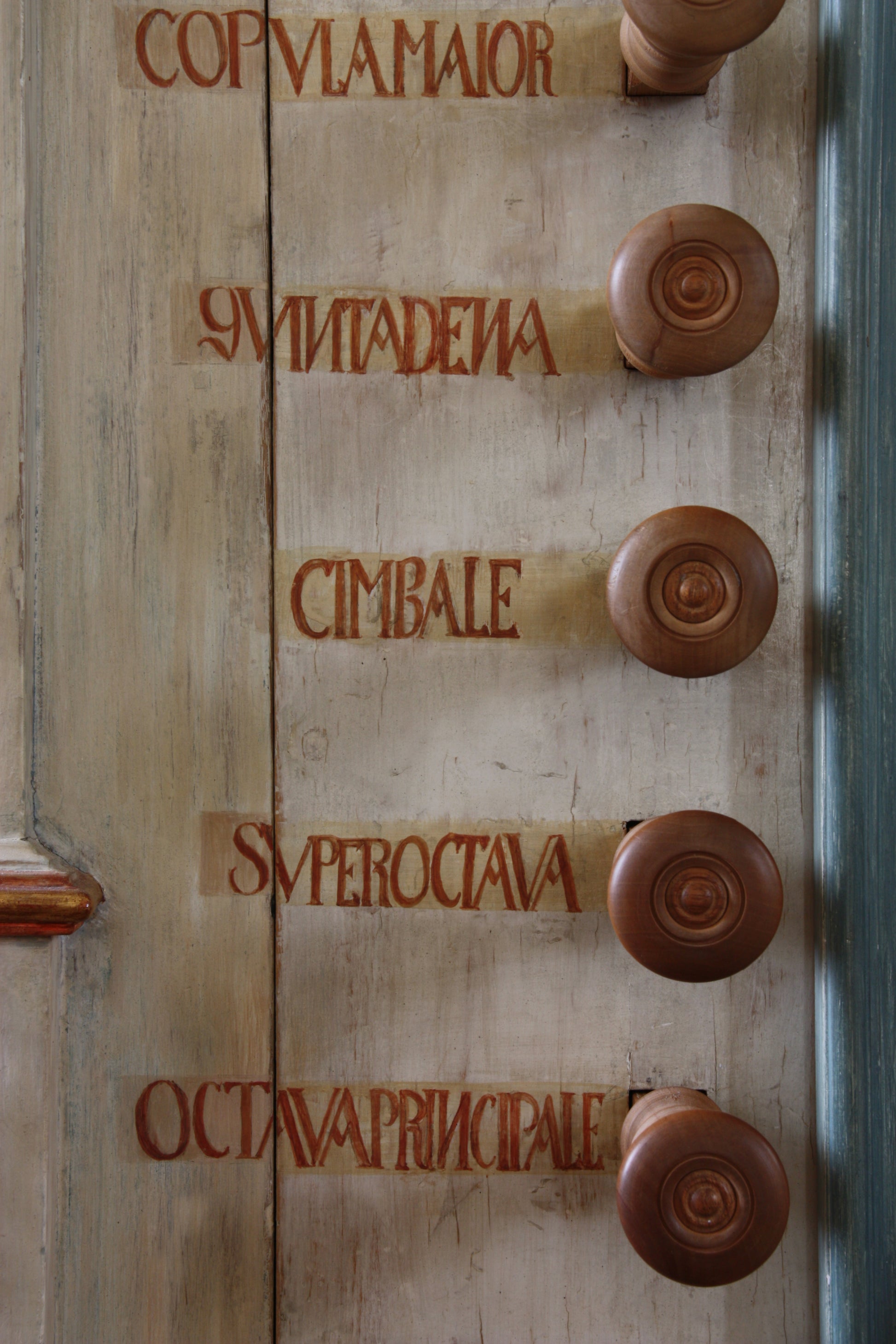
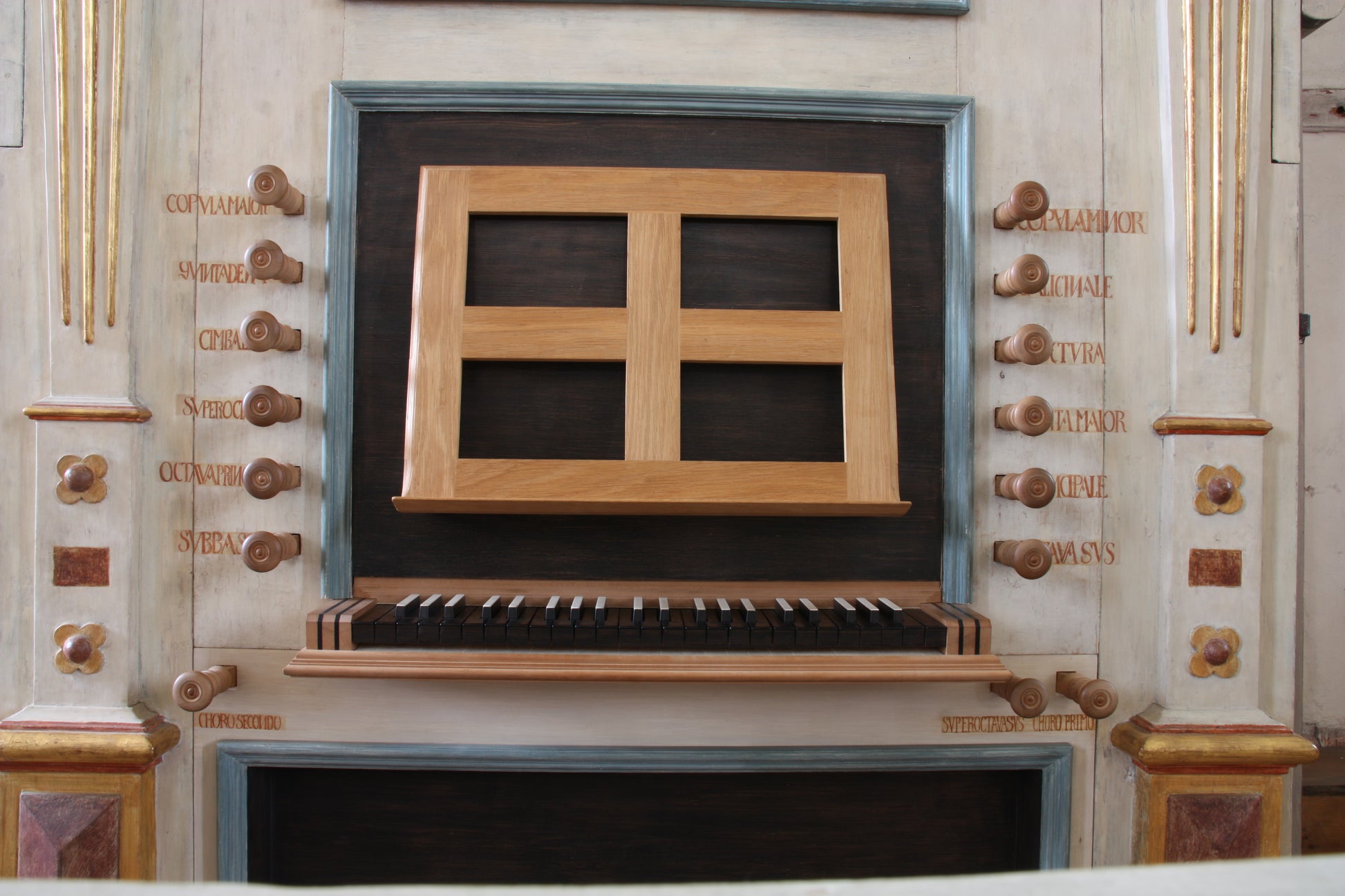
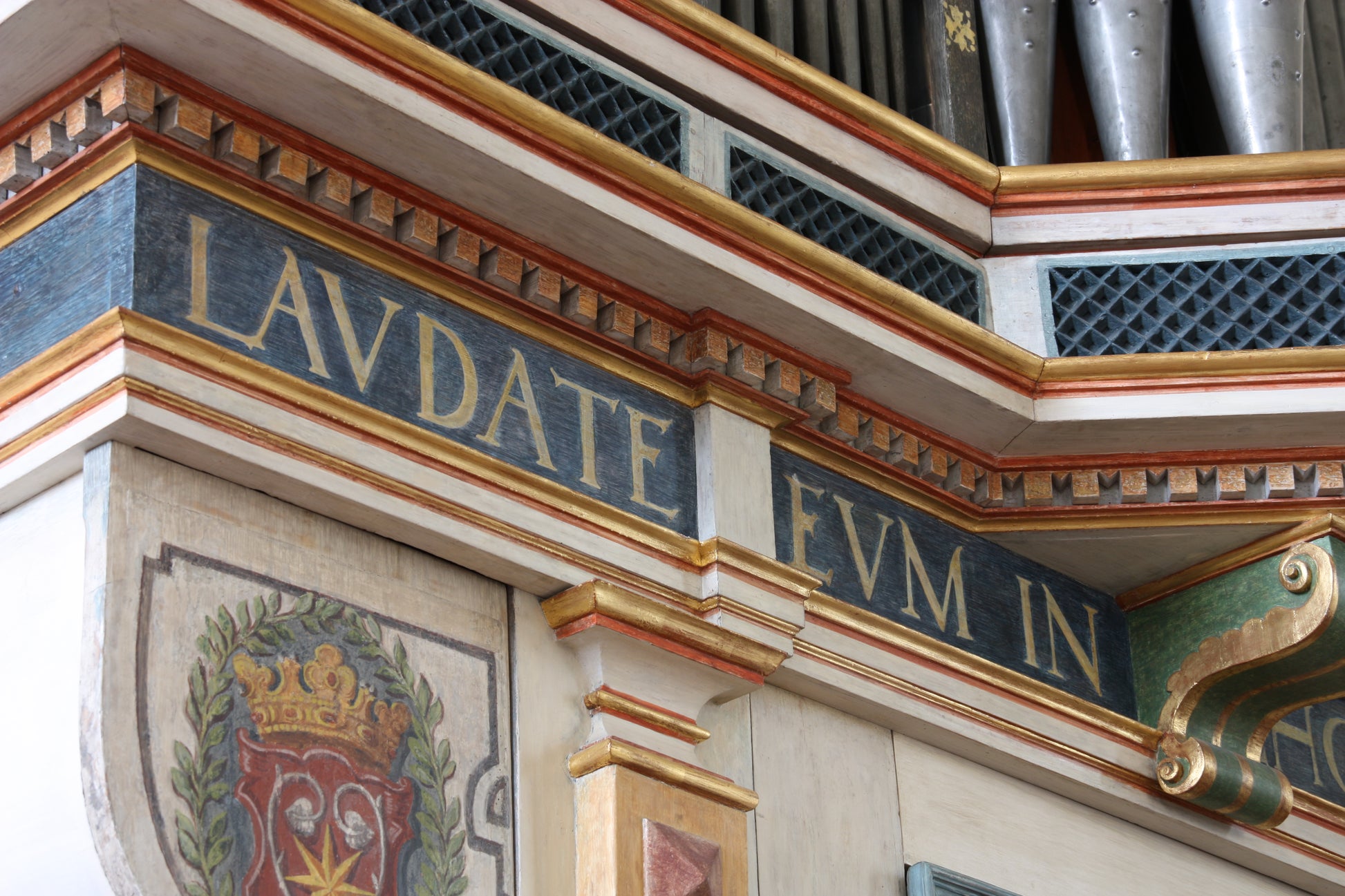

![Casavant, 1995 [Obra principal]](http://artful.shop/cdn/shop/files/ss_casavant1.jpg?v=1693319885&width=533)
![Bückeburg, 1997 [Obra principal]](http://artful.shop/cdn/shop/files/ss_bueckeburg1.jpg?v=1692967628&width=533)
![Schwerin, Dom, Ladegast Organ 1871 [Hauptwerk]](http://artful.shop/cdn/shop/files/ladegast1.jpg?v=1759140126&width=533)
![Segovia, 1772 [Obra maestra]](http://artful.shop/cdn/shop/files/ss_segovia1.jpg?v=1714213906&width=533)
![Reuter, 1928 [Obra principal]](http://artful.shop/cdn/shop/files/ss_Reuter1.jpg?v=1693321024&width=533)
![Rotterdam Hoofdorgel, 1973 [Hauptwerk]](http://artful.shop/cdn/shop/files/ss_RotterdamMain1.jpg?v=1693279529&width=533)
![Groninga, 1450-1740 [Obra principal]](http://artful.shop/cdn/shop/files/ss_Groningen1.jpg?v=1693275425&width=533)
![Frankfurt a.d. Oder, 1975 [Obra principal]](http://artful.shop/cdn/shop/files/ss_frankfurtoder1.jpg?v=1692974219&width=533)
![Piacenza, 1838 [Obra principal]](http://artful.shop/cdn/shop/files/ss_piacenza1.jpg?v=1693003521&width=533)
![Lüdingworth, 1683 [Obra principal]](http://artful.shop/cdn/shop/files/ss_luedingworth1.jpg?v=1692998051&width=533)